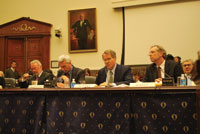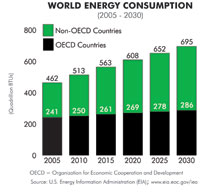The human quest to improve energy efficiency goes at least as far back as the discovery of fire. Humankind is constantly trying to strike a better deal with nature – for every unit of energy we consume, we expect more from it. Our ability to find innovative ways to tap into animal, chemical and mechanical energy sources has improved exponentially in recent centuries.
 But a confluence of 21st century challenges has made that quest all the more urgent. Climate change threatens to alter the planet’s ecosystems. Rising middle classes in emerging economies are increasing global energy demand. Ballooning populations in the world’s developing regions strain the world’s food and energy supplies. Writer Thomas Friedman has referred to this as the world becoming hot, flat and crowded.
But a confluence of 21st century challenges has made that quest all the more urgent. Climate change threatens to alter the planet’s ecosystems. Rising middle classes in emerging economies are increasing global energy demand. Ballooning populations in the world’s developing regions strain the world’s food and energy supplies. Writer Thomas Friedman has referred to this as the world becoming hot, flat and crowded.
The U.S. Energy Information Administration projects world energy consumption will grow by 50 percent between 2005 and 2030. These projections assume that current energy policies remain in place throughout the world. But that is very unlikely.
Governments, businesses and consumers now realize that finite sources of non-renewable energy cannot sustain a world of rapidly increasing energy demand. Alternative renewable energies need to be tapped. Buildings need to be retrofitted and redesigned to use energy more efficiently.
History provides a hopeful case study. In the decade leading up to 2005, Americans offset 75 percent of potential increases in energy usage through efficiency gains – dramatically reducing the need to tap into new energy sources.
Technology is the key to solving the world’s energy challenges. And the
TechAmerica – Helping To “Green”
In January 2009, TechAmerica was formed from the merger of AeA, formerly the American Electronics Association, and ITAA, the Information Technology Association of America. This merger created the largest and strongest resource for advancing the business of technology in the
TechAmerica serves a membership ranging from the largest, most recognized technology companies in the world to small start-up companies launched in garages and dorm rooms hoping to become the next household name. TechAmerica’s membership is diffused throughout the country and represents the diverse American technology landscape – from hardware manufacturers to telecommunications to software services and R&D labs.
The merger of AeA and ITAA into TechAmerica was a fortuitous match of influential organizations with complementary strengths. The birth of the new technology association coincided with the beginning of a new presidential administration committed to the transformative power of technology.
Even before day one of the new Administration, TechAmerica provided support and advice to President Obama and his senior staff as they explored how technology and innovation would drive the future of the American economy.
 Technology is essential for long-term economic growth and prosperity, a key element of which is facilitating energy efficiency. Information and communication technologies from semiconductors to software have emerged as the new catalysts for improving productivity and energy efficiency. They will play a vital role in the greening of the
Technology is essential for long-term economic growth and prosperity, a key element of which is facilitating energy efficiency. Information and communication technologies from semiconductors to software have emerged as the new catalysts for improving productivity and energy efficiency. They will play a vital role in the greening of the
Technology will revolutionize the energy industry by tapping into renewable sources such as wind and solar power and creating more efficient methods to generate and distribute that energy. TechAmerica serves as an incubator for the growth of many small technology companies that are on the forefront of innovation by bringing them together with an investor community eager for new ideas and opportunities.
These small companies – small now like Google was small in the late 1990s – are the lifeblood of innovation and entrepreneurship, pioneering highly sophisticated technologies and providing specialized improvements to existing technologies.
Technology will dramatically improve energy efficiency by providing the building blocks for a smart energy grid. The same microchips that have long provided the brains for computers and cell phones can now be embedded in energy consuming appliances, allowing two-way communication across the electrical grid.
Currently, the electrical grid communicates and transmits energy in one direction – from the power plant to the home or business. Two-way communication is key to creating what is being termed the ‘Energy Internet’ – a smart electrical grid where appliances embedded with microchips are networked using advanced software to manage power consumption.
A smart electrical grid enables consumers to identify which home appliances are being used inefficiently and to reduce consumption during peak hours when energy usage is more expensive. The grid provides cities with greater access to alternative clean energy generators such as wind and solar power that are difficult to manage under the current grid. The grid allows utility companies to monitor power flow to consumers and respond more quickly to problems.
Enter the Federal Stimulus Package
The U.S. Congress and the Obama Administration seem to grasp the potential of technology to enhance energy efficiency. The 2009 American Recovery and Reinvestment Act – known more commonly as the federal stimulus package – includes funding that will apply the power of technology to the monumental energy and environmental challenges facing our country and the world.


